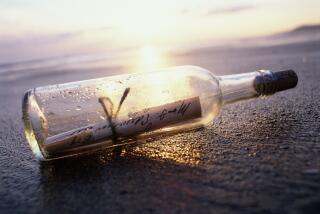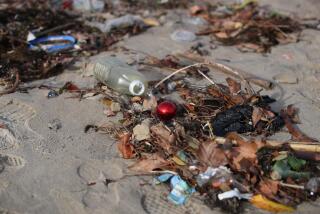Flotsam? We’re Gonna Get Some
- Share via
SEATTLE — Maybe you heard about those wandering bathtub toys, all those plastic duckies, that came washing up on West Coast beaches in recent years? Or the 80,000 pairs of Nike shoes? Or the waves of hockey gloves?
Well, get ready beachcombers, because those were just a tease. The mother lode of all oceanic merchandising spills is thought to be drifting our way now--perhaps tens of millions of lost Christmas presents and other unknown loot.
“This is the Big Bang, an incredible possible bonanza,” gushes Curtis C. Ebbesmeyer, an avuncular, gray-bearded Northwest scientist who also happens to be America’s foremost expert and enthusiast on matters of high seas flotsam.
Every so often, once a year or every other year, merchant ships plying the high seas trade routes encounter storms or mishaps, or an unfortunate convergence of the two. Cargo washes overboard, usually in containers. Some of the containers spring open. By Ebbesmeyer’s calculations, about one in 10 hold “something interesting”--which is to say, buoyant items that drift on the currents and winds, whirlpooling across thousands of miles of open ocean before washing ashore in telling patterns.
Seven years ago, 29,000 toy turtles, frogs, beavers and ducks went a swimming in the mid-Pacific. The image of bathtub toys on the raging seas was so nearly perfect that when they began landing on beaches from Alaska south, it was enough to lift Ebbesmeyer and his work from obscurity.
He turned out to be just about the only doctorate-level source in the English-speaking world who actually studied floating objects in the ocean and could explain where things like this came from, how long they stayed, where they would end up and what they might teach us about our world.
Add in some history, a dash of sea-salt romance and real life “Message in a Bottle” projects for schoolchildren, and Ebbesmeyer now finds himself with a scientific hobby that consumes two days a week and brings him more attention than his day job as a private consultant plotting paths of oil spills and pollutants in the ocean.
Items Making Way Toward Third Ocean
As for the yellow duckies, untold thousands are still bobbing out there somewhere along with blue turtles, red beavers and green frogs. Any day now Ebbesmeyer expects to receive word that they have crossed from the Pacific and made their way through the icy Arctic Ocean to take a swim in the Atlantic. First sightings are likely on the coast of Iceland or Britain.
Meanwhile, just in time for the millennium, the West Coast awaits the fresh bounty of a savage typhoon named Babs. It could beat all known records for flotsam by tenfold.
In October, the storm swept across the North Pacific with a force that was described as a “meteorological bomb.” It overran several ships en route from Asia, including two bound for Los Angeles and one for Seattle. Shipping officials and crew gave only general accounts of their cargo--consumer goods including Christmas toys, furniture, televisions and clothing.
In 60-foot waves and 100 mph winds, the ships broached and heaved. One of them, the APL China, lost somewhere between 366 and 406 containers from on deck. A second ship gave up 23 containers and a third vessel lost 22 containers. A single container can weigh 10 tons and carry, say, 16,000 sneakers.
The maritime bulletin “The Cargo Letter” called it the worst--or, as beachcombers might view it, the best--loss since the invention of containers in 1954.
High seas cargo spills are mostly private matters between shippers and insurance companies. Details are not easy to come by. But the big spills known to have occurred in the recent past have been in the range of 10 to 20 containers, with one load of 49 containers yielding tens of thousands of hockey gloves, Avia sneakers and Lightning Bolt beach thongs.
Using computer models, Ebbesmeyer and his colleague W. James Ingraham Jr. of the National Marine Fisheries Service, predict landfall for the latest merchandise this winter, perhaps as early as autumn. Exactly when depends on the type of products, since high-floating bathtub toys pick up more speed from winds than sodden sneakers or low-floating beer cans.
If, for example, the cargo included plastic duckies, they might begin washing ashore as soon as September. Hockey gloves would not arrive until November. Sneakers would begin showing up about January.
The projected target area covers most of the West Coast from the California-Mexico border to the Gulf of Alaska, with Northern California, Oregon and Washington likely to receive the densest share of the booty.
Ebbesmeyer asks people who find items washing up on the seashore to contact him at curt@evansham.com, so he can spread the word via his subscription newsletter, Beachcombers’ Alert!
Send all the detail possible, Ebbesmeyer says, because nature can pull some strange tricks.
Case in point: The 80,000 Nike high-tops that spilled into the Pacific a decade ago from a ship bound from South Korea to the U.S. The shoes were not tied together in pairs. As they became waterlogged, they turned turtle. Apparently one footprint presents a slightly different profile than the other to the wind and currents. When the shoes eventually drifted ashore, some beaches got mostly lefts and other places rights.
“Everything that washes up is teaching us something,” Ebbesmeyer enthuses. “In this case, we see that nature is pretty tidy and puts everything in a certain place.”
For awhile people on the Oregon coast held “meet and match” events to trade lefts for rights and sort out sizes.
Ownership of such flotsam is a delicate question. Maritime law holds that finders are not legal keepers. Things lost at sea belong to their original owners, although it’s not usually a contentious issue with random, waterlogged and weather-beaten goods, sometimes encrusted with barnacles or chewed by curious fish or mammals. A full container with undamaged products would likely be another matter.
‘Insidious’ Plastic Pellets
In some instances, Ebbesmeyer wishes that owners would be held more responsible, particularly when it comes to those ubiquitous white pellets that are the raw material for molded plastic goods. Lost to history are the records of container spills that have littered beaches all over the world with these pellets. California lifeguards call them “nurdles.” Ebbesmeyer calls them “far more insidious than oil.” At the least, the little pellets, like foam bubbles, are unsightly litter that’s almost impossible to clean up. And who knows what harm they pose to foraging wildlife?
By his calculations, just 25 containers of these would carry enough plastic pellets to spread 100,000 per mile along the world’s 372,000 miles of seashore.
“Oil spills grab the headlines, but this is a silent menace,” he says.
Worse still are small glass ampuls, like 2-inch long-neck beer bottles. Not to be mistaken for collectible glass fishing floats, these sealed, medicinal-looking ampuls contain a brown liquid thought to be hazardous chemicals from the 1940s, perhaps washing up from a World War II shipwreck or an old oceanic dump. They have been reported on beaches from Guam and Hawaii to Florida, and may contain poisonous compounds used for making insecticides.
On the other hand, some massive old-growth timbers are now floating in the North Pacific and could bring finders $5,000, Ebbesmeyer says. The beams are 24-inches square and 40-feet long clear Douglas Fir--the kind of wood that is nearly impossible to harvest today. The timber went down in the Pacific Northwest in a 1921 shipwreck. After years buried in a hold and protected from damaging organisms, the beams have broken loose and are now adrift.
The wandering paths of floating objects in the oceans have endlessly fascinated people. Centuries before anyone thought to study the routes of winds and currents scientifically, people set messages afloat in bottles and barrels for the random wonder of where they might wash up and what far-off stranger might be touched.
Sometimes the stories are almost as sentimental as Hollywood’s “Message in a Bottle,” like the heiress who bottled up her last will and dropped it into the Thames River in England in 1936, offering the finder a half-share in her fortune. Ebbesmeyer has spent years trying to track down and authenticate the story of the unemployed man who claimed to have found the bottle in 1949 near San Francisco.
He has verified a 1912 note from an Imperial Russian Navy vessel, released in a bottle north of Japan and found in 1996 in Alaska’s Prince William Sound, as well as other bottles that have bobbed from ocean to ocean and traveled more than 20,000 miles.
Columbus’ Logs Still Missing
These days, Ebbesmeyer and a colleague periodically visit schools to get children interested in geography and maritime commerce by writing their own bottle messages. A friendly ship captain then sets the corked wine bottles afloat at locations of historical seafaring interest, such as off the Azores in the Atlantic.
There, in February 1493, a homeward-bound Christopher Columbus packed a copy of his log book in a barrel and threw it overboard when he thought his ships would founder in a storm. The log contained the record of his landing in the New World.
The log was never found, but when the children’s bottles someday wash up they will yield hints where the barrel might have come ashore.
Begun in 1997, the project has so far set afloat 149 bottles. One, released near Cuba, has already been found on a beach near Key West. The others could drift until today’s children have schoolchildren of their own.
“It helps kids become alive to the world,” says Ebbesmeyer. Not to mention the rest of us.
Researcher Anna M. Virtue contributed to this story.
More to Read
Sign up for The Wild
We’ll help you find the best places to hike, bike and run, as well as the perfect silent spots for meditation and yoga.
You may occasionally receive promotional content from the Los Angeles Times.






